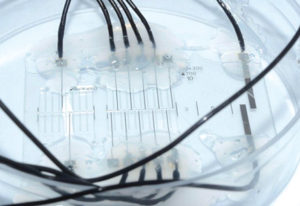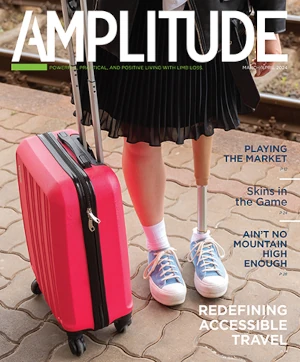
© 2018 Florent-Valéry Cohen.
Scientists at the École Polytechnique Fédérale de Lausanne (EPFL), Switzerland, have developed a miniaturized electronic platform for the stimulation and recording of peripheral nerve fibers on a chip. The platform paves the way for using chips to improve neuroprosthetic designs, which may lead to restoration of the sense of touch for people who use prosthetic devices, silence painful nerve activity, and help people with paralysis walk.
The scientists used the platform to test a photothermic method for inhibiting neural activity to treat pain. “Neural inhibition could be a way to treat chronic pain like the phantom limb pain that appears after an arm or leg has been amputated, or neuropathic pain,” said Stéphanie Lacour, PhD, a professor at EPFL’s school of engineering, and one of the study’s authors.
The “nerve-on-a-chip” platform can stimulate and record information from explanted nerve fibers, just as an implanted neuroprosthesis would. The platform contains microchannels embedded with electrodes, and explanted nerve fibers faithfully replicate the architecture, maturity, and functioning of living tissue.
Stimulating nerves at the right place and the right time is essential for implementing effective treatments, but is challenging due to implants’ inability to record neural activity precisely. “Our brain sends and receives millions of nerve impulses, but we typically implant only about a dozen electrodes in patients. This type of interface often doesn’t have the resolution necessary to match the complex patterns of information exchange in a patient’s nervous system,” said Sandra Gribi, a PhD student at the Bertarelli Foundation Chair in Neuroprosthetic Technology, and first author.
The researchers tested their platform on explanted nerve fibers from rats’ spinal cords, trying out various strategies for stimulating and inhibiting neural activity. “In vitro tests are usually carried out on neuron cultures in dishes. But these cultures don’t replicate the diversity of neurons, like their different types and diameters, that you would find in vivo. Resulting nerve cells’ properties are changed. What’s more, the extracellular microelectrode arrays that some scientists use generally can’t record all the activity of a single nerve cell in a culture,” said Gribi.
The nerve-on-a-chip platform can be manufactured in a clean room in two days and is able to rapidly record hundreds of nerve responses with a high signal-to-noise ratio. However, what really sets it apart is that it can record the activity of individual nerve cells.
To use the platform to treat chronic pain and phantom limb pain, the research team deposited a photothermic semiconducting polymer on some of the chip’s electrodes. “The polymer heats up when subject to light,” said Gribi. “Thanks to the sensitivity of our electrodes, we were able to measure a difference in activity between the various explanted nerve fibers. More specifically, the activity of the thinnest fibers was dominantly blocked.” The thin fibers are nociceptors—the sensory neurons that cause pain. The next step will be to use the polymer in an implant placed around a nerve to study the inhibiting effect in living tissue, according to the researchers.
The researchers also used the platform to improve the geometry and position of recording electrodes to develop an implant that can regenerate peripheral nerves. “That will enable engineers to develop bidirectional, selective implants allowing for more natural control of artificial limbs such as prosthetic hands,” said Lacour.
The research was published October 23 in Nature Communications.
This story was adapted from materials provided by EPFL.



